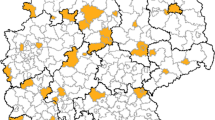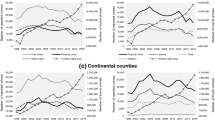Using Casinos for Growth: The Benefits and Limits of Commercial Gambling as an Economic Development Strategy

The last three decades have seen explosive growth in the commercial gambling industry. Researchers have correspondingly studied the impacts of this industry as it emerged. This chapter draws together a number of key findings from the economics literature on casinos as the basis for informed regional development policy. The use of casino gambling as a tourism amenity is explained, followed by findings from the literature on social costs of casinos. These costs are contrasted by the literature on how casinos impact a number of important economic indicators including employment, income, and tax revenues. A number of geographic considerations of these benefits are then enumerated, including spatial limits. The chapter concludes with a short list of policy considerations for jurisdictions considering the legalization of commercial gambling as a basis for economic development.
This is a preview of subscription content, log in via an institution to check access.
Access this chapter
Subscribe and save
Springer+ Basic
€32.70 /Month
- Get 10 units per month
- Download Article/Chapter or eBook
- 1 Unit = 1 Article or 1 Chapter
- Cancel anytime
Buy Now
Price includes VAT (France)
eBook EUR 128.39 Price includes VAT (France)
Softcover Book EUR 168.79 Price includes VAT (France)
Hardcover Book EUR 168.79 Price includes VAT (France)
Tax calculation will be finalised at checkout
Purchases are for personal use only
Similar content being viewed by others

Regulatory objectives vs fiscal interests: Are German casino locations motivated by beggar-thy-neighbor policy? An empirical analysis
Article Open access 23 November 2022
Riverboat casino gambling impacts on employment and income in host and surrounding counties
Article 27 November 2015

More Tourism, More Crime: Evidence from Croatia
Article 16 July 2019
Notes
Grinols (2004) attempts a full benefit/cost analysis, but his analysis contains multiple critical flaws. See Walker (2007a) for a detailed critique.
This difference between VLTs and casinos is interesting, as it has been noted that “VLTs are actually video poker machines that have minor payout differences from the same devices in casinos” (Eadington 1996, p. 4). Humpherys and Soebbing (2014) acknowledge that it is possible their VLT regression model is mis-specified, but the difference in results may also stem from the locations where VLTs are placed (usually in bars), which differ substantially from stand-alone casinos.
References
- American Gaming Association. (2017). State of the states: The AGA survey of the Casino industry. Washington D.C.: American Gaming Association. Google Scholar
- Barron, J. M., Staten, M. E., & Wilshusen, S. M. (2002). The impact of casino gambling on personal bankruptcy filing rates. Contemporary Economic Policy,20(4), 440–455. ArticleGoogle Scholar
- Calcagno, P. T., & Walker, D. M. (2016). A review of regulatory theory and the U.S. Casino industry. Journal of Gambling Business and Economics,10(1), 14–39. ArticleGoogle Scholar
- Cotti, C. (2008). The effect of casinos on local labor markets: A county level analysis. The Journal of Gambling Business and Economics,2(2), 17–41. ArticleGoogle Scholar
- Cotti, C. D., & Walker, D. M. (2010). The impact of casinos on fatal alcohol-related traffic accidents in the United States. Journal of Health Economics,29, 788–796. ArticleGoogle Scholar
- Eadington, W. R. (1995). Economic development and the introduction of casinos: Myths and realities. Economic Development Review,13(4), 51–54. Google Scholar
- Eadington, W. R. (1996). The legalization of casinos: Policy objectives, regulatory alternatives, and cost/benefit considerations. Journal of Travel Research,34(3), 3–8. ArticleGoogle Scholar
- Economopoulos, A. J., & Luxem, U. (2015). Examining the impact of competition on casino revenues and prices in the Mid-Atlantic States. UNLV Gaming Research and Review Journal,19(1), 1–15. Google Scholar
- Gallagher, R. M. (2014). An examination of cannibalization effects within the riverboat gaming industry: The case of the Illinois-area casinos. Growth and Change,45(1), 41–59. ArticleGoogle Scholar
- Garrett, T. A., & Nichols, M. W. (2008). Do casinos export bankruptcy? The Journal of Socio-Economics,37(4), 1481–1494. ArticleGoogle Scholar
- Geisler, K. R., & Nichols, M. W. (2016). Riverboat casino gambling impacts on employment and income in host and surrounding counties. The Annals of Regional Science,56(1), 101–123. ArticleGoogle Scholar
- Grinols, E. L. (2004). Gambling in America. Cambridge: Cambridge University Press. BookGoogle Scholar
- Grinols, E. L., & Mustard, D. B. (2006). Casinos, crime, and community costs. The Review of Economics and Statistics,88(1), 28–45. ArticleGoogle Scholar
- Hicks, M. J. (2014). Do good fences make good neighbors? The cross border impact of casino entrance. Growth and Change,45(1), 5–20. ArticleGoogle Scholar
- Hsu, C. H. C. (2000). Residents’ support for legalized gambling and perceived impacts of riverboat casinos: Changes in five years. Journal of Travel Research,38, 390–395. ArticleGoogle Scholar
- Humpherys, B. R., & Soebbing, B. P. (2014). Access to legal gambling and the incidence of crime: Evidence from Alberta. Growth and Change,45(1), 98–120. ArticleGoogle Scholar
- Israeli, A. A., & Mehrez, A. (2000). From illegal gambling to legal gaming: Casinos in Israel. Tourism Management,21, 281–291. ArticleGoogle Scholar
- Kang, Y.-S., Long, P. T., & Perdue, R. R. (1996). Resident attitudes toward legal gambling. Annals of Tourism Research,23, 71–85. ArticleGoogle Scholar
- Lim, S. H., & Zhang, L. (2017). Does casino development have a positive effect on economic growth? Growth and Change,48(3), 409–434. ArticleGoogle Scholar
- McCartney, G. (2016). Play the cards, roll the dice—The integration of casinos within Asian tourism destination development strategy. UNLV Gaming Research & Review Journal, 20(2). Google Scholar
- Nichols, M. W. (1998). Deregulation and cross-border substitution in Iowa’s riverboat gambling industry. Journal of Gambling Studies,14(2), 151–172. ArticleGoogle Scholar
- Nichols, M. W., Tosun, M. S., & Yang, J. (2015). The fiscal impact of legalized casino gambling. Public Finance Review,43(6), 739–761. ArticleGoogle Scholar
- Nichols, M. W., & Tosun, M. S. (2017). The impact of legalized casino gambling on crime. Regional Science and Urban Economics,66, 1–15. ArticleGoogle Scholar
- Pizam, A., & Pokela, J. (1985). The perceived impacts of casino gambling on a community. Annals of Tourism Research,12, 147–165. ArticleGoogle Scholar
- Popp, A. V., & Stehwien, C. (2002). Indian casino gambling and state revenue: Some further evidence. Public Finance Review,30(4), 320–330. ArticleGoogle Scholar
- Roehl, W. S. (1994). Gambling as a tourist attraction: Trends and issues for the 21st century. In A.V. Seaton (Ed.), Tourism: The State of the Art (pp. 156–68). New York: Wiley. Google Scholar
- Sen, A. K. (1999). Development as freedom. New York: Anchor Books. Google Scholar
- Sévigny, S., Ladouceur, R., Jacques, C., & Cantinotti, M. (2008). Links between casino proximity and gambling participation, expenditure, and pathology. Psychology of Addictive Behaviors,22(2), 295–301. ArticleGoogle Scholar
- Stitt, G. B., Nichols, M. W., & Giacopassi, D. (2005). Perception of casinos as disruptive influences in USA communities. International Journal of Tourism Research,7, 187–200. ArticleGoogle Scholar
- Suh, E., & West, J. J. (2010). Estimating the impact of entertainment on the restaurant revenues of a Las Vegas hotel casino: An exploratory study. International Journal of Hospitality Management,29(4), 570–575. ArticleGoogle Scholar
- Walker, D. M. (2007a). Book review: Gambling in America. Southern Economic Journal,73(3), 830–832. Google Scholar
- Walker, D. M. (2007b). Problems in quantifying the social costs and benefits of gambling. American Journal of Economics and Sociology,66(3), 609–646. Google Scholar
- Walker, D. M., & Collin, D. H. (2018). Gambling taxes. In A. J. Hoffer & T. Nesbit (Eds.), For your own good: Taxes, paternalism, and fiscal discrimination in the twenty-first century (pp. 361–447). Google Scholar
- Walker, D. M., & Jackson, J. D. (2011). The effect of legalized gambling on state government revenue. Contemporary Economic Policy,29(1), 101–114. ArticleGoogle Scholar
- Walker, D. M., & Jackson, J. D. (2013). Casinos and economic growth: An update. Journal of Gambling Business and Economics,7(2), 80–87. Google Scholar
- Walker, D. M., & Nesbit, T. M. (2014). Casino revenue sensitivity to competing casinos: A spatial analysis of Missouri. Growth and Change,45(1), 21–40. ArticleGoogle Scholar
- Walker, D. M., & Sobel, R. S. (2016). Social and economic impacts of gambling. Current Addiction Reports,3(3), 293–298. ArticleGoogle Scholar
- Wenz, M. (2008). Matching estimation, casino gambling and the quality of life. The Annals of Regional Science,42(1), 235–249. ArticleGoogle Scholar
- Wenz, M. (2014). Valuing casinos as a local amenity. Growth and Change,45(1), 136–158. ArticleGoogle Scholar
Author information
Authors and Affiliations
- Department of Economics and Finance, College of Business, Idaho State University, 921 South 8th Ave., Stop 8020, Pocatello, ID, 83245, USA Karl R. Geisler
- Karl R. Geisler



